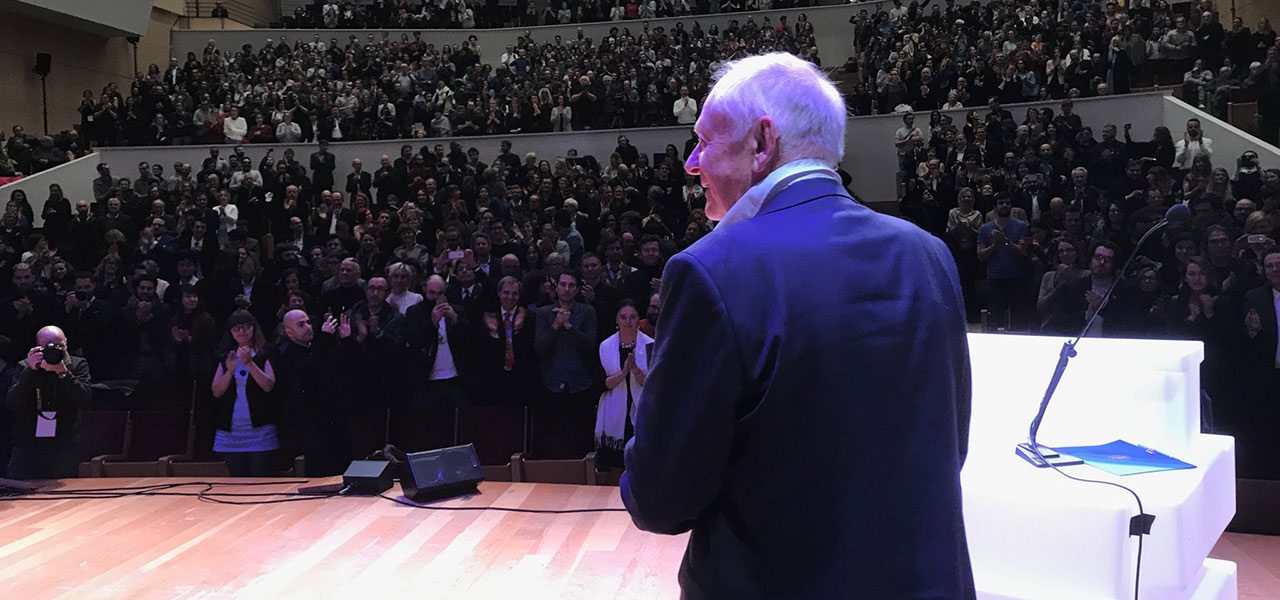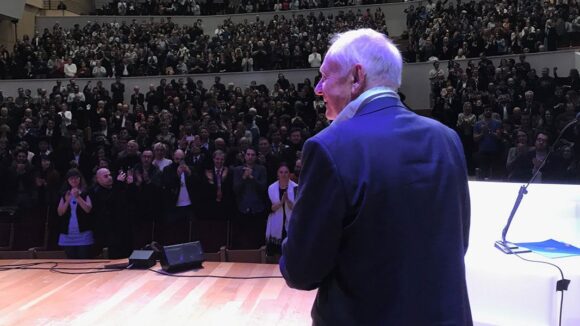

European Animation Awards: 7 Takeaways From A Historic Evening
The much-anticipated first edition of the European Animation Awards (EAA) took place last Friday, December 8, in Lille, France. The inaugural ceremony attracted well over a thousand enthusiastic attendees, followed by a cocktail buffet with a smaller group.
Cartoon Brew attended the event, and spoke to its organizers and attendees, discussing things the EAA can do to strengthen a pan-European animation culture, how its first edition succeeded in those aims, and what parts of the event still have room for improvement and development.
Here are seven key things to understand about the Emiles.
1. Bringing unity to the European animation field
European animation is thriving, both in terms of quality and quantity.
“I feel like it’s the Golden Age of animation in Europe,” enthused Irish director, Cartoon Saloon co-founder, and EAA jury member Tomm Moore (Song of the Sea, The Secret of Kells).
But European countries still need each other to thrive; they often depend on international co-production to create large-scale projects like features and series. A pan-European award encourages a sense of togetherness, or “for the animation field to feel like one body,” as Aardman co-founder and EAA president Peter Lord put it. “Somehow all these different countries are moving together,” he continued, “like one ship, firing off beautiful fireworks.”
But how inclusive is the EAA really, I wondered when observing the stage and the audience at the ceremony. As well as a lack of female and racial representation (the former promising, but definitely not near equal; the latter almost non-existent), it was noticeable that people from Northern, Eastern and Southern Europe were largely underrepresented.
Animafest Zagreb director Daniel Šuljić said, “We should be very positive and mild [about the first edition of the Emiles], but also not overlook the fact that an award which has the intention to be all European, wasn’t. If we count the board members, presenters, nominees, and winners, and even the people talking in the Richard Williams tribute video, over 95% are from Western Europe.”
If the Emiles aims to be a pan-European party, they should work on the diversity in their organization and presenters, and consider traveling to different places for future editions. Only then can the Emiles become truly European, instead of Western European, and the event an inclusive gathering for all Europeans.
2. Celebrating the ‘doers’
Animation equals teamwork – most of the time – and that’s exactly what the EAA wants to honor. Modeled after Los Angeles’ Annie Awards, many of the Emile Awards recognize specialized areas of the art form.
“It celebrates the profession of animation,” stated Belgian programmer Karin Vandenrydt (Anima Festival), “whereas festivals celebrate the auteurs.” More specifically, the EAA wants to honor the ‘doers’; the animators, the storyboard artists, the writers, and so on – the people who usually don’t get to be on stage or at awards parties. EAA president Lord hopes the doers “will feel like [the EAA] is their festival.”
Do they feel like that, though? On stage, accepting the prizes, were mostly the directors and producers we already know and admire. That’s not to say there were no ‘doers’ present at all. There were some, like Irish art director Lily Bernard (Cartoon Saloon’s Puffin Rock). She was excited to attend, explaining, “When you make things, you don’t realize so much if people like it. Especially since European productions don’t have a lot of merchandising…Attending an event like this is very motivating.”
But then again, many ‘doers’ were absent (or too shy to give an acceptance speech on stage). A beautiful irony was to be found, for example, in the acceptance speech of My Life as a Courgette’s award for best soundtrack; the person accepting the award explained that the composer couldn’t accept the award herself, because she was “stuck in the studio right now” working on the soundtrack of the producer’s next film.
The EAA’s aim to celebrate ‘doers’ is lovely, but it definitely doesn’t feel like their party just yet. It’ll take for the attending producers and directors to encourage and/or bring their crew, and that will take for the EAA organization to highly encourage the producers and directors to do so.
#AnimafestZg creative director Daniel with our dear friend @PeteLordAardman at #EmileAwards tonight! 🥂 pic.twitter.com/vdIhSf1o7E
— Animafest Zagreb (@Animafest_Zg) December 8, 2017
3. Boosting Europeans’ confidence
The list of EAA nominees is a glamorous bundle of quality animation of which Europeans can be proud. “It’s a confidence boost,” said Dutch director and EAA nominee Michael Dudok de Wit (The Red Turtle). “It gives nominees and winners the confidence to continue [their work]. It’s a confidence boost for the whole industry.”
Producer and EAA jury member Tom van Waveren (Cake Entertainment) added that, in their daily work, “every creator and producer lives in their own reality. When voting for the Emiles, they get a good feel for the top-quality level we as Europeans can achieve.”
Nominees were selected by juries, with three members each, and then the winners were decided on by all EAA members. “Peers have a certain sensitivity that feels very deep,” said Dudok de Wit.
Added director of Greece’s Animasyros Festival and EAA jury member, Maria Anestopoulou, “It’s the collective opinion of so many different people that makes the Emiles a unique honor.”
4. Showcasing the breadth of European animation
Tomm Moore found that if there’s one thing that defines Europe, it’s diversity, in terms of designs, stories, techniques, and target audiences. “In the U.S., when you say feature-length animation film, it’s usually one type of style and audience,” he explained. “In Europe, when you say feature-length animation film, it can be anything.”
While the diversity that Moore talks about was indeed present in EAA’s nominations and winners, there were few surprises, with many productions nominated in several categories. You’d think specialized categories would open up the floor for lesser-known works as well.
Unfortunately this is inevitable, jury member Van Waveren argued. “You can see which projects are quite well-funded…It’s like good wine with a good meal.” Well-funded productions are often of high quality in all areas, and similarly, underfunded ones are often lower quality in all areas.
All the winners of the first-ever #EmileAwards pic.twitter.com/oDTNBZjlYR
— Cartoon Brew (@cartoonbrew) December 8, 2017
5. Presenting European animation to the world
As we all know, animators are predominantly modest and inward-looking. Lord hope the EAA can be ‘a kick in the butt’ for the whole industry to get out there and present themselves.
Tomm Moore expanded on the idea: “A European movie is usually second choice when people go to watch a film, as opposed to American blockbusters. We should make the public aware that we offer them something special.” Moore imagined that it “would be great if people would be like, “Oh, what won the EAA?,” and go watch that. With the EAA we’re advocating and promoting what we’re doing as a community.”
The Emiles have the potential to do what the Annies did, Croatian producer and EAA nominee Draško Ivezić (Manivald) argued. “The Annies help a wider audience to notice stuff that’s not Disney/Pixar. Bringing a window to independent projects is always good.”
Of course, the EAA has some way to go before its brand is established in the mainstream. Russian director and EAA short film nominee Anna Budanova (Among the Black Waves) recalled the moment her distributor told her she got an EAA nomination, and she replied, “That’s great! But what is it?”
Polish director and EAA nominee Paulina Ziolkowska (Oh Mother!) shared that her mom reacted to the news by asking how she could vote for the film. In order for the EAA to fulfill its promotional potential it’ll simply have to grow older. (Although parents enthusiastically asking where they can vote for you will probably be a thing forever …)
6. Adding some glamour to the animation industry
Animation generally doesn’t know how to present itself glamorously, like live-action does. I found it quite refreshing to be at a semi-chic awards night, with tuxedos and cocktail dresses here and there, a spacious theater, and a mostly slick ceremony.
At the same time the event presented a healthy dose of lightheartedness, largely thanks to host Christophe Erbes, who got down on one knee for Peter ‘My Lord’ Lord, and did a little dance on stage. “It’s just, once every blue moon, let’s take seriously what we do every day,” said German director Jan Lachauer, who shared two awards for Revolting Rhymes. “That doesn’t mean not to involve humor; just like festivals, the EAA can decide its vibe.”
The EAA’s vibe, at least during this first edition, was “glamorous and classy yet relaxed,” as Lily Bernard described it. It seems to me the perfect fit for the animation community.
Emocionante la entrega del Lifetime Achievement Award a Richard Williams @RWAnimator en la ceremonia de los #EmileAwards pic.twitter.com/F9mMNGZQdq
— 3DWIRE (@3DWIRE) December 8, 2017
7. Bringing indie and industry together
In Europe, more than anywhere else in the world, it’s natural for artists to hop from independent to commercial projects. One year a background artist works on a low-budget short, the next they’re on a well funded feature-length film. “You can see that overlap here, in the attendance and the nominees,” Revolting Rhymes co-director Bin-Han To observed.
While there was an atmosphere of respect and collaboration between all attendees, balancing indie and industry within one event is tricky. Many attendees already felt the Emiles understated the importance of shorts. After all, “Europe’s animation tradition is rooted in artistic shorts,” Šuljić said. EAA board member Olivier Catherin also acknowledged that it would be nice to add more categories in future editions, especially concerning shorts. However, “we’d have to be able to do that without making it a three hour-long ceremony…”
If the EAA succeeds in bringing indie and industry together more in its upcoming editions, that’d be fantastic for both groups. Dudok de Wit explained, “It’s good to make producers and investors realize that unusual films are important to get made, through the fact that those films are acknowledged here. Money is not the only reason films should get made.”
Growing the Emiles would mean growing its influence, but it would also mean an even bigger crowd, which limits attendees’ opportunity to make new connections. If the EAA were to grow, it needs to build an infrastructure – perhaps through more focused side-events – that truly connect attendees from different sides.
Lord stressed beforehand that this first edition will be evaluated extensively. Is the European Animation Awards beneficial for the European animation industry? I’d say yes, sure, there’s lots of potential, and it’s already an event worth marking on European professionals’ calendars. Can the European Animation Awards be improved? Again, I’d say yes, of course.
In the meantime, while the EAA further contemplates its ambitions and methods, Šuljić summed up the general sentiment that was to be felt throughout the evening: “A celebration of animation is always a good idea.”
(Photo at top via Peter Lord)

.png)